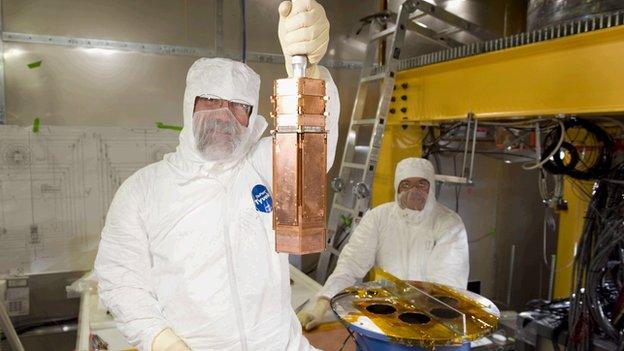Dark matter experiment CDMS sees three tentative clues
- Published

The CDMS experiment is based underground at the Soudan mine in Minnesota, US
Researchers have revealed the first potential hints of the elusive material called dark matter at an underground laboratory in the US.
Though it is believed to make up a quarter of our Universe, dark matter - true to its name - has never been seen.
Scientists at the American Physical Society meeting, external showed three promising clues to it from the CDMS experiment, external.
However, they stressed the preliminary nature of the results and that more data are needed to confirm it.
Physics has a well-defined threshold for claiming that a new particle has been discovered, and this result still falls far short of that.
Nevertheless, given the feverish pitch of the hunt for dark matter - in other underground labs, at the Large Hadron Collider in Switzerland, and even in space - these three early hints have caused a stir at the meeting.
"It's certainly something we want to be investigating," CDMS collaborator Blas Cabrera of Stanford University told BBC News.
"This is science, and the further tightening up of what we see - or excluding it - is very important for us to do."
Four-way search
Dark matter is believed to interact only very rarely with the normal matter we know well.
Deep within a mine in the US state of Minnesota, CDMS - which stands for Cryogenic Dark Matter Search - tries to catch those rare interactions as dark matter particles bump into the nuclei of atoms in a detector that is held at temperatures near that of deep space.
The facility reported two potential dark matter sightings in 2010, but those later turned out to come from the instrument itself.
The new results - to be posted to the preprint server Arxiv, external - show three signals that should only have a 0.19% chance of showing up if there were no particle causing them, around the level of what physicists call a "three-sigma" result.
They suggest a less massive dark matter particle than commonly considered - about nine times that of the proton - but one that is still consistent with some theories.
Further, it does not match up with results published in Physical Review Letters, external from another underground experiment in Italy called Xenon.
More clarity will come, as is often the case, with more data.
"We're actually in a good situation in the whole of the field," said Bernard Sadoulet of the University of California Berkeley, referring to the four types of experiments being used around the world - and within it and below it - to finally track dark matter down.
"These four ways… we can rely on to help us work through these hints," he told the meeting.
The hint-laden data were taken when CDMS used detectors made of silicon; it has since moved on to germanium detectors.
But Prof Cabrera said the team was aiming to re-install the silicon, just to check on the unexpected hints announced here.
"The fact that we're looking at changing our strategies to include silicon means it's certainly exciting."
- Published7 September 2011
- Published25 July 2010